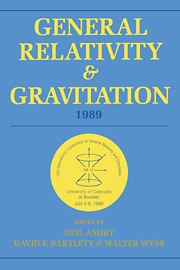 General Relativity and Gravitation, 1989
General Relativity and Gravitation, 1989 Book contents
- Frontmatter
- Contents
- Preface
- Conference committees
- Part A Classical relativity and gravitation theory
- WORKSHOPS
- Part B Relativistic astrophysics, early universe, and classical cosmology
- 5 Gravitational lenses: theory and interpretation
- 6 Recent observations of gravitational lenses
- 7 Inflation and quantum cosmology
- 8 Theory and implications of cosmic microwave background Radiation
- 9 The cosmic microwave background: present status of observations, and implications for general relativity
- WORKSHOPS
- Part C Experimental gravitation and gravitational wave detection
- WORKSHOPS
- Part D Quantum gravity, superstrings, quantum cosmology
- WORKSHOPS
- Part E Overviews-past, present, and future
8 - Theory and implications of cosmic microwave background Radiation
Published online by Cambridge University Press: 05 March 2012
- Frontmatter
- Contents
- Preface
- Conference committees
- Part A Classical relativity and gravitation theory
- WORKSHOPS
- Part B Relativistic astrophysics, early universe, and classical cosmology
- 5 Gravitational lenses: theory and interpretation
- 6 Recent observations of gravitational lenses
- 7 Inflation and quantum cosmology
- 8 Theory and implications of cosmic microwave background Radiation
- 9 The cosmic microwave background: present status of observations, and implications for general relativity
- WORKSHOPS
- Part C Experimental gravitation and gravitational wave detection
- WORKSHOPS
- Part D Quantum gravity, superstrings, quantum cosmology
- WORKSHOPS
- Part E Overviews-past, present, and future
Summary
Anisotropies of the temperature of the Cosmic Background Radiation (CBR) give us unique information on the universe at redshifts of about 1000. By using observational limits on these anisotropies we can constrain the parameters of cosmological models and the spectrum and amplitude of the initial perturbations. Additional information on the thermal history of the universe is provided by distortions of the CBR spectrum. In this paper we give an overview of physical processes leading to anisotropies in popular cosmological models.
Introduction
The remarkable isotropy of the CBR in a universe containing so many structures is one of the most fascinating cosmological observations. Strong limits put on possible anisotropies of the CBR let us impose important constraints on models of global structure of the universe, and on models of galaxy and cluster formation.
The difference between the CBR and all the other radiations investigated in astronomy is that the former existed from the beginning of the universe, and the latter were created only after first objects were formed. Also, the CBR has now a 2.74K blackbody spectrum, and the radiation of astronomical objects is usually not blackbody.
Following the discovery of the CBR (Penzias and Wilson (1965)), progress in observations has been rapid. Currently, anisotropies on the level of 10−4 – 10−5 are detectable on a wide range of angular scales and frequencies. (Observations of anisotropy are usually made by comparing intensities of radiation detected by two antennas, separated by an angle θ, the angular scale.
- Type
- Chapter
- Information
- General Relativity and Gravitation, 1989Proceedings of the 12th International Conference on General Relativity and Gravitation, pp. 205 - 222Publisher: Cambridge University PressPrint publication year: 1990


